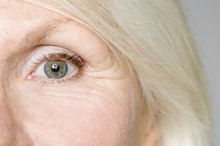How to Firm Up Skin After Menopause
Menopause brings about many changes in your body's functions, hormonal composition, and appearance. One of the more noticeable changes is the loss of your skin's elasticity, characterized by loose, saggy "wattles" and deep wrinkles. Menopause brings about a decrease in your body's production of collagen and elastic fibers. This is due in part to the natural aging process and also to a lack of estrogen, which plays a part in collagen production. However, you don't need to simply resign yourself to sagging skin after menopause. With a proper skin care regimen, you can maintain a healthy, youthful appearance.
Use a glycolic acid moisturizer. A strong glycolic acid moisturizer coupled with exfoliation can go a long way toward firming, smoothing and hydrating skin. A strong glycolic acid moisturizer can also be irritating, but if used correctly, this can be advantageous to sloughing off age spots and rough skin. Learn how to use these products within a realm that is tolerable to your skin. Discuss your skin type with a dermatologist before deciding on a glycolic acid moisturizer.
What Are the Benefits of Retinol Cream?
Learn More
Try a collagen-building cream. Any cream that has the capacity to generate collagen in your skin can improve your skin's thickness, resilience and elasticity. Various prescription vitamin A creams are considered effective in this capacity. Among these are Renova, Tazorac, Retin-A and tretinoin cream. Some of these creams make your skin more sensitive to the sun. Talk to your doctor about the benefits and risks of these products.
Estrogen replacement, either in the form of medical treatment or through creams available over-the-counter, may help firm your postmenopausal skin 3. However, estrogen replacement therapy may carry an increased risk of breast cancer, and its use has been decreased in recent years. While the effects of estrogen creams are not yet known, you should not assume these products are safe. Hormone treatments should not be undertaken simply to improve skin. Talk to your doctor about these treatment options.
Does Kojic Acid Cause Acne?
Learn More
Use sunscreen -- it is important skin protection for people of all ages. Not only does it reduce risk of skin cancer, but it fortifies your skin against further signs of aging. Use a sunscreen containing 5 percent or more of micro-sized zinc oxide.
Related Articles
References
- Cosmetic Dermatology: Treatment of Estrogen-Depleted Skin
- Clinical Interventions in Aging: Effect of Estrogens on Skin Aging and the Potential Role of SERMs
- Kubiak M, Mucha P, Dębowska R, Rotsztejn H. Evaluation of 70% glycolic peels versus 15% trichloroacetic peels for the treatment of photodamaged facial skin in aging women. Dermatol Surg. 2014 Aug;40(8):883-91. doi: 10.1097/01.DSS.0000452669.84787.bf.
Writer Bio
Jennifer Byrne is a freelance writer and editor specializing in topics related to health care, fitness, science and more. She attended Rutgers University. Her writing has been published by KidsHealth.org, DietBlogTalk.com, Primary Care Optometry News, and EyeWorld Magazine. She was awarded the Gold Award from the American Society of Healthcare Publication Editors (ASHPE), 2007, and the Apex Award for Publication Excellence.









